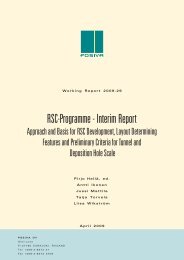Bentonite Mineralogy Part 1: Methods of Investigation - Posiva
Bentonite Mineralogy Part 1: Methods of Investigation - Posiva
Bentonite Mineralogy Part 1: Methods of Investigation - Posiva
You also want an ePaper? Increase the reach of your titles
YUMPU automatically turns print PDFs into web optimized ePapers that Google loves.
10<br />
4) Another recommended method is preparation on porous plate. However, this method<br />
is not used in Finland.<br />
3.1.2 Solvation and heating<br />
The aggregates are dried at room temperature and the XRD patterns recorded. The<br />
identification <strong>of</strong> expandable clay minerals includes solvation with ethylene glycol or<br />
glycerol that are able to enter the interlayer positions. The recommended method is to<br />
keep the clay aggregate for long enough time in ethylene glycol (EG) vapour at elevated<br />
temperature (24 hat 80°C, Driefet al., 2001; at least 48 hours at 60°C, Olsson, 1991; at<br />
least 8 h at 60°C, Moore & Reynolds, 1997; 12 hours at 70°C, Claret et al., 2002).<br />
Glycerol solvation has to be done by adding a drop <strong>of</strong> liquid on the wet clay aggregate<br />
and letting it almost dry. This can disturb the orientation and the quality <strong>of</strong> pattern is<br />
<strong>of</strong>ten poor, because the aggregate has to be run wet. Solvation with EG shifts the lowcharge<br />
vermiculite and smectite 001-peak position from 12- 15 A to 16- 17 A.<br />
Glycerol solvation shifts the 001-peak <strong>of</strong> Mg-saturated smectite to 17- 18 A whereas<br />
the vermiculite 00 1-peak remains unchanged at 14 - 15 A. Heating both vermiculite and<br />
smectite to 300°C and higher temperatures causes dehydration and shifts the 001-peak<br />
to 10 A.<br />
Examples <strong>of</strong> preparation and solvation methods used in bentonite research:<br />
- Inoue et al. (1987): The < 1 J-lm fraction <strong>of</strong> untreated clay samples was isolated by<br />
centrifugation. The suspensions were smeared on glass slide, dried at room<br />
temperature, solvated with ethylene glycol (EG) vapor, and examined by XRD<br />
- Drief et al. (2002): The< 2 J-lm fraction was isolated, smeared on glass slide, dried at<br />
room temperature, solvated with ethylene glycol at 80°C for 24 h, heated at 550°C<br />
for 1 h<br />
- Churchman (2002): EG-solvation: The aggregates were placed in a vacuum<br />
desiccator over ethylene glycol liquid and left there for at least 2 days. Saturation<br />
with Mg on membrane filter: The sample on the filter was covered twice with 1 M<br />
MgCh for at least 10 min, the excess electrolytes were removed by washing with<br />
deionized water at least three times.<br />
- Kirsimae et al. (1999): XRD slides were obtained by sedimentation on a porous<br />
porcelain plate under pressure or by smearing on a glass slide (sub fractions <strong>of</strong> the <<br />
2J.!m material: 2-0,6, 0,6-0,2, 0,2-0,06 and < 0,06 J-lm). Solvation with ethylene<br />
glycol vapour: 60°C, 48 h. Heat treatment: 525°C, 2 h. Mg-exchange: 1 M MgCh<br />
overnight.<br />
3.1.3 060 reflections<br />
The d-value <strong>of</strong> the 060 (06-33) reflection <strong>of</strong> clay minerals is used for distinction<br />
between dioctahedral and trioctahedral types. This is because the cell b-dimension is<br />
sensitive to the size <strong>of</strong> the cation and the site occupancy in the octahedral sheet. The<br />
d(060) value <strong>of</strong> dioctahedral minerals like kaolinite and muscovite is around 1,49 A

















